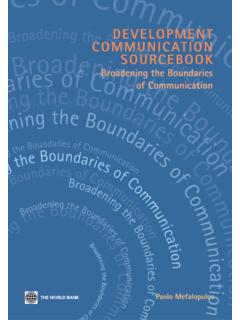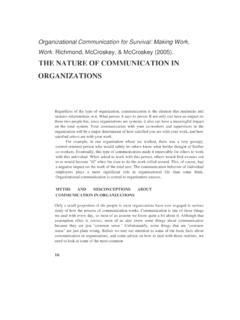Transcription of The Psychology of Verbal Communication
1 The Psychology of Verbal CommunicationRobert M. KraussColumbia UniversityNote: This is an unedited version of an article to appear in theforthcoming edition of the International Encyclopedia of the Socialand Behavioral Sciences (edited by N. Smelser & P. Baltes).scheduled for publication in occurs when signals carry information-bearing messagesbetween a source (or sender) and a destination (or receiver). Although allspecies communicate, human Communication is notable for its precisionand flexibility, a consequence of the uniquely human ability to uselanguage. Language endows human Communication system with theproperties of semanticity, generativity, and displacement, allowing peopleto formulate an unlimited number of meaningful novel messages that arenot tied to the immediate present.
2 At a fundamental level verbalmessages convey meanings the speaker has encoded into the words of anutterance, but a listener who has understood the utterance has gonebeyond the literal meaning of the words and grasped the particular sensein which the speaker intended them to be understood. In order to do so,communicators must make their coparticipants' perspectives part of theprocess of formulating and interpreting messages. Thus anycommunicative exchange is implicitly a joint or collective activity inwhich meaning emerges from the participants' collaborative Psychology of Verbal Communication22 Although linguists think about language as an abstract structure--a set ofprinciples that specify the relations between a sequence of sounds and a sequenceof meanings--to its users, what is most significant about language is its versatilityas a medium for Communication .
3 The ability to communicate is vital to a species'survival, and all animal species communicate, some in ways that are impressivelyproficient. But none achieve the precision and flexibility that characterizes humancommunication, a capacity due in large part to the uniquely human ability to uselanguage (Deacon, 1997; Hauser, 1996).ELEMENTS OF Communication SYSTEMSAll Communication systems, regardless of how simple or complicatedthey may be, operate on the same principle: Signals transmit messages from asource to a destination. The distended belly of the female stickleback signals themale to initiate an elaborate courtship routine that culminates in fertilization ofher eggs (Tinbergen, 1952). Upon returning to its hive, a foraging honeybeecommunicates the direction and distance of a source of nectar by engaging in anelaborate waggle-dance (von Frisch, 1967).
4 Vervet monkeys (native to EastAfrica) have three distinctive vocal alarm calls that signal the presence ofleopards, eagles and snakes, their three main predators. Upon hearing one oranother call, a Vervet will respond appropriately--climbing a tree in response tothe leopard call, scanning the ground when the snake call is sounded (Seyfarth,Cheney & Marler, 1980). Each of these systems represents the species' adaptationto the exigencies of a particular ecological niche in which communicationfacilitates survival, Language can be thought of as a similar sort of systems use two kinds of signals: signs and symbols. Signsare signals that are causally related to the message they convey. We say thatblushing means someone is embarrassed because we know that embarrassmentis a cause of blushing.
5 Symbols, on the other hand, are products of socialThe Psychology of Verbal Communication33conventions. Because of an implicit agreement among speakers of English, thesound pattern we recognize as the word dog denotes the familiar category offurry, four-legged creatures. There is no intrinsic reason that dog, rather thansome other sound pattern, should convey that message, and in languages otherthan English of course very different sound patterns represent the concept Communication often involves both signs and symbols. The tremulousvoice that tells us a speaker is experiencing distress is a sign, , a direct productof the distress it signals. But it is the symbolic content of Verbal communicationthat accounts for its extraordinary , GENERATIVITY AND DISPLACEMENTL anguage is only one of the symbol systems humans use to "thumbs-up" gesture conveys the message of success, approval or hope; thewedding ring and the mourner's ribbon publicly proclaim the wearer's currentstatus; a facial grimace in response to the question "How did you like the movie?
6 "symbolically and effectively expresses the person's assessment. Notwithstandingthe utility of such symbolic displays, language endows human communicationwith three properties, semanticity, generativity, and displacement, that collectivelydistinguish it from other sorts of symbolic displays and from the forms ofcommunication observed in other species. Semanticity: In human Communication , signals stand for things, which isto say that they have meaning. An overheated dog will pant to dissipateheat, and an astute observer may understand the panting to indicate thatthe dog is hot, but panting cannot be said to stand for overheatedness inthe same way that the word "overheated" does. Generativity (sometimes called Productivity): All languages are capable ofgenerating an infinite number of meaningful messages from a finitenumber of linguistic signals.
7 Languages allow symbols to be combined andThe Psychology of Verbal Communication44recombined in ways that yield novel meanings, and any competentlanguage user will regularly produce and comprehend utterances thathave never been uttered before, but are immediately comprehensible to allcompetent language users. Even so sophisticated a system as the Vervet'salarm calls is limited to a fixed set of messages, and lacks the ability togenerate novel ones. For the Vervet, there is no way to signal the presenceof predators other than eagles, leopards or snakes. Displacement: Language makes it possible to communicate about thingsthat are remote in space or time, or indeed exist only in the Russell once remarked that "No matter how eloquently a dogmay bark, he cannot tell you that his father was poor but honest.
8 "Although the observation is self-evident, even banal, it points to afundamental difference in the expressive capacities of language and othercommunication modalities. Vervets can signal the presence of a predatoryeagle, but even the most articulate Vervet cannot refer to the eagle thatattacked a week ago; their Communication is limited to what is immediatepresent. Perhaps more than any other feature, it is the capacity of languageto convey displaced messages that distinguishes it from othercommunication ability of language to generate an unlimited number of meaningfulnovel messages that are not bound to the here and now, combined with thecognitive capacity to exploit these properties, allows human Communication to beextraordinarily effective and versatile.
9 The full extent of this effectiveness andversatility is revealed by an examination of how Communication systems work,Regardless of the type of signal, all Communication involves the transfer ofinformation between a source and a destination. Anthropologists Daniel Sperberand Denise Wilson characterize it as:..a process involving two information-processing devices. One devicemodifies the physical environment of the other. As a result, the seconddevice constructs representations similar to the representations alreadystored in the first device (Sperber & Wilson, 1986, p. 1).The description applies equally well to the transmissions of a fax machine, thegesticulations of a policeman directing traffic, or a conversation among Psychology of Verbal Communication55In human Communication the "information processing devices" are people, the"representations" are mental representations or ideas, and the "modifications ofthe physical environment" are the uniquely human disturbances of the acousticsurround called Communication PARADIGMSP recisely how is language used to convey information?
10 There are manycharacterizations of the ways language functions as a medium forcommunication, but the major ways are captured by four models or paradigms(Krauss & Fussell, 1996). Each paradigm focuses on a different dimension oflanguage use, and might be thought of as a necessary but incomplete descriptionof the process. The four paradigms are: the Encoding-Decoding paradigm, theIntentionalist paradigm, the Perspective-Taking paradigm, and the and Decoding: Language often is described as a code that useswords, phrases and sentences to convey meanings,. A code is a system that mapsa set of signals onto a set of significates or meanings, and in the simplest kind ofcode, the mapping is one-to-one: for every signal there is one and only onemeaning; for every meaning, there is one and only one signal.



















